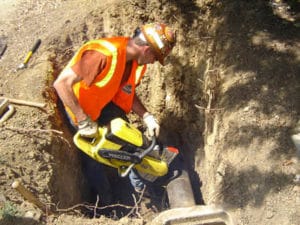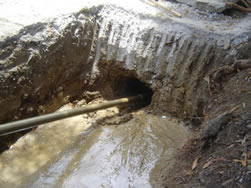An Effective and Reliable Water Supply – Critical for Firefighting
The District is also tasked with ensuring the overall adequacy of the pipeline infrastructure within its boundaries for firefighting purposes. It is a basic requirement that sufficient water (in terms of both flow and pressure) is available for fire protection throughout the District. Provisioning, upgrading, and maintenance of these water mains and fire hydrants are performed in conjunction with the water districts that serve our community, as part of their mission to provide domestic water to local residents.
To obtain the required reliability, all major pipelines within the district are configured in loops so that water can reach a given point from two directions. Besides doubling the effective available flow rate, this also provides a measure of reliability through redundancy. In case of a break or other problem, a small section of a pipeline can be isolated for repair without impacting water delivery to other points on the loop. Wherever possible, dead-end pipelines are limited to short spurs serving relatively few residences.
With the continuing development of new residences over the past decades, we occasionally need to upgrade existing pipelines to provide more capacity or install new ones in areas that were not previously served. Given the sometimes hilly terrain and already developed nature of much of the Town, this activity can be very complex.
Standard Construction

Usually, the first step is to mark the exact location of an existing pipeline and if necessary, obtain any necessary easements that may be required for new pipelines.


The existing pipeline is located and a portion cut out preparatory to installing a “T” with its requisite shut-off valves.


The trench is prepared to its full depth and a new section of ductile cast-iron water main is lowered into place, preparatory to connecting it to the rest of the system.


The “T” with its three shut-off valves is lowered into the trench so that it can be connected to the existing pipeline and provide the new branch. Then finally the pipeline is covered with a layer of crushed rock and soil, both of which must be carefully compacted prior to the final restoration of the roadbed and resurfacing.
Construction Through Non-Level Terrain
“Boring” rather than “Trenching”
One of the most difficult situations that may be encountered is the need to route a pipeline up a hill that is too steep for negotiation by by the trenching equipment, or the path may be blocked by a stand of mature trees or other obstacles.
In this case, a novel approach is used that effectively tunnels a new pipeline without the need to dig trenches.

First two pits are excavated – one at each end of the prospective “tunnel”. Then a long drill, consisting of sections of small diameter pipe headed by a drill-bit, is inserted into the wall of the starting pit, and drilling proceeds in the direction of the target pit.
In the left-hand picture below, you can just see that the pit has been excavated right next to an existing pipeline with a very small bore that needs to be upgraded to accommodate a larger diameter pipe. In the center picture you can see the drill-bit and the first length of the drill as it is prepared to start the process. As the drill penetrates further towards its destination, more lengths of pipe are attached from the rig that can be seen in the background. This rig also powers the drill.



After this fatter bit has been pulled through and in the process has reamed out the tunnel to a wider diameter, an even fatter bit is attached. The process is repeated with increasingly larger diameter bits, incrementally widening the tunnel. to the diameter of the pipeline itself.



Eventually, the diameter of the tunnel is sufficient for a final draw where the pipeline itself can be attached and drawn into the tunnel. As each section of the pipeline is pulled into the tunnel, a new section is attached until eventually the new pipeline stretches from one end of the tunnel to the other.


In the left-hand picture below, you can see the lubricating slurry collecting in the pit as the drill-bit is is being pulled back through the tunnel, In the right-hand picture, the first section of the new pipeline has been attached to the end of the drill, prior to being drawn into the tunnel.


Ensuring a sound and sufficient pipeline and fire hydrant infrastructure for the district is a major function of the Los Altos Hills County Fire District. This work occurs on a continuing basis as new pipelines are required, or existing ones need to be upgraded (due either to age deterioration or new capacity requirements).
This work is performed using some of the most knowledgeable and skilled contractors in the business, using state-of-the-art techniques to ensure cost-effective but quality work.
Images courtesy of Pakpour Consulting Group Inc.







